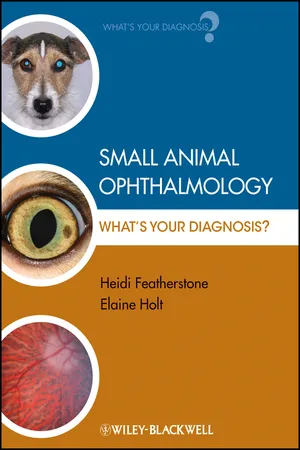
Small Animal Ophthalmology
What's Your Diagnosis?
Heidi Featherstone, Elaine Holt
- English
- ePUB (handyfreundlich)
- Über iOS und Android verfügbar
Small Animal Ophthalmology
What's Your Diagnosis?
Heidi Featherstone, Elaine Holt
Über dieses Buch
Small Animal Ophthalmology: What's Your Diagnosis? is one of the first books in an exciting new series that combines problem-based learning, case studies, and questions and answers. Designed specifically for veterinarians and students, the series aims to present material in a format to enhance critical thinking and understanding.
Adopting a case-based approach, chapters are built around common ophthalmic presentations and are directed by questions to test the reader's ability to interpret clinical history, ophthalmic photographs and diagnostic results in order to provide differential diagnoses, diagnostic plans and treatment options.
For veterinary students, this book is an ideal guide to how ophthalmology cases are handled in the clinical setting. For veterinary practitioners, it is an innovative and interesting way to increase their knowledge and skills in clinical ophthalmology.
Häufig gestellte Fragen
Information



- Chronic glaucoma In contrast to the dog, primary glaucoma in the cat is rare, and secondary glaucoma is more common. The most common causes of secondary glaucoma in the cat are chronic idiopathic lymphocytic-plasmacytic uveitis and primary intraocular neoplasia, most notably diffuse iris melanoma. Typical clinical signs include buphthalmos, conjunctival and episcleral congestion, corneal oedema, mydriasis, and impaired or absent vision. Buphthalmos can be difficult to discern in the cat and assessment of the size of the palpebral fissure can be helpful because it becomes wider as the size of the eye increases. Glaucoma in cats is typically insidious in onset and is often difficult to recognise. This is in contrast to canine primary glaucoma which is characterised by peracute pain, episcleral congestion, marked corneal oedema, mydriasis and blindness (Ch. 6, case 2).
- Exophthalmos Anterior displacement of the globe within the orbit. Common causes of exophthalmos in the cat include orbital neoplasia, orbital cellulitis/abscess and orbital trauma (haematoma, emphysema, fracture, foreign body). Primary malignant neoplasia and abscesses secondary to dental disease are more likely in old cats, whereas head trauma and orbital foreign bodies are more common in young cats (Ch.12, case 2).
- Systemic hypertension Sustained systemic hypertension is commonly associated with ocular manifestations which primarily involve the posterior segment but also affect the anterior segment. Abnormalities in the posterior segment involve the retina, choroid and vitreous humour and appear as retinal oedema and bullae, retinal and intravitreal haemorrhages, retinal detachment and increased tortuosity of the retinal arterioles. Intraocular haemorrhage can occur as a result of haemorrhage from the iris (Fig. 1.1d), ciliary body, retina, and choroid. Extensive hyphaema can lead to the formation of anterior and posterior synechiae and secondary glaucoma.
- Coagulopathy and platelet disorders Ocular haemorrhage can be a clinical sign of a coagulopathy or a platelet disorder. Ocular haemorrhage typically occurs when the platelet count is <50 000 cells/µl.
- Uveitis When there is a breakdown of the blood-aqueous barrier during inflammation, red blood cells can enter the anterior chamber (hyphaema). The blood may form either a homogenous layer in the ventral anterior chamber or a clot, as in this cat.
- Trauma Ocular haemorrhage may result from both blunt and penetrating ocular trauma (Ch. 12, cases 2 and 3).
- Pre-iridal fibrovascular membrane (PIFM) The formation of fibrovascular membranes on the anterior iris is usually a consequence of intraocular inflammation, haemorrhage and/or hypoxia due to the release of vasoactive substances. Hence the formation of PIFMs is common in eyes with chronic uveitis, intraocular haemorrhage, retinal detachment, glaucoma, and neoplasia. The newly formed blood vessels within the membranes are fragile and can cause spontaneous and recurrent hyphaema. PIFMs can extend into the filtration angle and result in secondary glaucoma. Fibrovascular membranes are not restricted to the surface of the iris – they can also form on the retina and optic disc and in the vitreous.
- Neoplasia (primary or secondary) Intraocular haemorrhage may occur in eyes affected with primary or secondary neoplasia, either originating from a PIFM or as a result of the direct effect of neoplasia (e.g. adverse effect on clotting function).
- Congenital anomalies These include persistent hyaloid artery and persistent hyperplastic primary vitreous, both of which are rare conditions in the cat.

- Ocular reflexes
- Pupillary light reflex – the left pupil is not visible. Negative consensual OS (from left to right eye); positive direct OD, albeit slow and incomplete.
- Dazzle reflex – negative OS, positive OD
- Palpebral reflex – positive OU, OS < OD
- Corneal reflex – positive OU, OS < OD
- Menace response – negative OS, equivocal OD
- Examination with a focal light source – in the left eye, slit-lamp biomicroscopy reveals extensive superficial and deep corneal vascularisation, and generalised corneal oedema and fibrosis which is most marked axially.
- Ophthalmoscopy – in the right eye, this reveals an extensive dorsal retinal detachment, most marked within the medial quadrant, and multiple retinal haemorrhages of different sizes throughout the tapetal fundus and ventral to the optic disc (Fig. 1.1e).
- Schirmer tear test – 4 mm/min OS, 10 mm/min OD
- Fluorescein dye – negative staining OD, positive staining in the superficial axial cornea OS. This is indicative of suboptimal ocular surface health in the left eye, most likely because of the lagophthalmos.
- Tonometry – IOP 35 mmHg OS, 20 mmHg OD

- B-mode ocular ultrasound – this is indicated to evaluate the posterior segment when the anterior segment is opaque, and to take m...